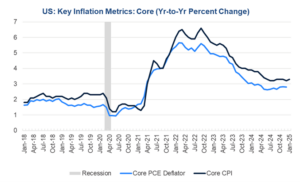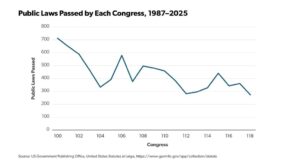Thought of the Week:
Whether novice or connoisseur, a trip to California’s wine country can be overwhelming for any oenophile. My wife prefers Napa Valley with its 16 American Viticultural Areas (AVAs) and the ease of accessing its 475 wineries—north on Rt. 29 in the morning and back south on the Silverado Trail in the afternoon. I’m partial to nearby Sonoma Valley, its 19 AVAs, 425 wineries, and home to Ridge Vineyards (my favorite) whose 1971 Monte Bello Cabernet Sauvignon won the reenactment of the Judgment of Paris by an astounding 18 points. Among the various tastings offered are “verticals,” which are wines produced under the same label but from different years; “horizontals,” wines from the same year, style, and AVA, but from different producers; and “AVA series,” wines from the same producer, year, and style but from different AVAs. Keeping up with the flurry of activity that has come out of President Trump’s first three weeks in office is a bit like trying to keep one’s palate cleansed during a vertical while drinking straight from a Balthazar, which is twice the size of a Jeroboam, which is twice the size of a Magnum, which is twice the size of a standard bottle of wine. Although the administration’s strategy is to use Executive Orders (EOs) to flood the valley to stymie political, legal, and media opposition, already, a number of these EOs have been met with preliminary court injunctions and all have left Democrats much less willing than they already were to cooperate with the continuing onslaught of Trump releases. And while a sommelier might tell you in vino veritas, the political truth is that Speaker Johnson and Senate Majority Leader Thune will need the cooperation of at least some congressional Democrats in just a few short weeks to avoid a March 14 government funding shutdown and later to address the debt-limit cliff. In the meantime, what can companies do to decant the volatility coming out of the White House and Congress? Our trade associations, consultants, and congressional staffers recommend a number of best practices:
- Stay true to core corporate values: the federal government is but just one stakeholder.
- Play the long game: the Trump administration will be in office for four years and the 119th Congress runs through 2026.
- Engage Congress and executive branch agencies directly: use Washington staff but also include local staff in advocacy efforts both in the nation’s capital and in district.
- Prepare for crises, investigations, and hearings: know which political/legislative/regulatory issues are critical to your business, construct crisis management teams, and conduct internal war exercises.
- Remember there is safety in numbers: build networks, form coalitions, and utilize trade associations.
Just as a sophisticated government affairs corporate best practices effort will guard a business against becoming corked, developing a sophisticated wine palate will lead one to the realization that while Sonoma makes wine, NAPA makes auto parts.
Thought Leadership from our Consultants, Think Tanks, and Trade Associations
American Enterprise Institute (AEI) Says Even the Threat of Tariffs Causes Inflation. The latest Consumer Price Index (CPI) suggests that inflation is on the rise, with a 0.5% month-over-month price rise in January and a 4.5% annualized rate since the presidential election. One contributing factor is the Trump administration’s threatened and announced tariffs. While tariffs, when imposed, raise the price level mechanically, they also affect inflation even when they are merely likely to be imposed in the future. There are two mechanisms through which this happens. First, importers attempt to front-run the tariffs, increasing demand for imported goods and putting upward pressure on prices. Second, everyone in the economy acts to increase consumption today, when prices are low, relative to tomorrow, when they will be high. We’ve even seen this second mechanism offered up as a solution to deflation. Nearly a quarter of a century ago, public policy officials proposed deploying similar actions to combat deflation and aggregate demand shortfalls in Japan. The proposal was to announce a gradual increase in Japan’s value added tax (VAT) of 1% per quarter to continue until the VAT reached 20%. The intention was for tax-induced inflation to give households an incentive to spend sooner rather than waiting until prices are substantially higher.
The Center for Strategic and International Studies (CSIS) Unpacks Last Week’s Flurry of Tariff Activity. Concerning last week’s tariffs on China and the now-postponed tariffs on Canada and Mexico, the main lesson is that what Trump really wants in the short term is a victory he can brag about, which is what he got. It showed that Canadian Prime Minister Trudeau and Mexican President Sheinbaum learned how to play him—politely insist on national sovereignty, make minor concessions, and let him declare victory. In terms of tariffs as revenue raisers, the Committee for a Responsible Federal Budget estimates that the China, Canada, and Mexico tariffs, if imposed, would bring in $1.4 trillion over ten years, while the cost of extending Trump’s tax cuts is estimated at $4.6 trillion over the same period, confirming what numerous economists have pointed out, the math doesn’t add up. In fact, the reality is that Trump’s actions make reshoring less likely. Companies thinking about new investments focus on three big issues (and a host of smaller ones). First, is the target a rule-of-law country or does the government make arbitrary decisions? Second, is there policy stability? And last, is there a mechanism for resolving commercial disputes that is transparent, efficient, and objective? The White House is in the process of trashing all three, and we may see the result of that as wary investors look elsewhere.
Eurasia Group Goes on Trump’s Global Heavy Metal Tour. President Trump’s 25% tariffs on metals are likely to be imposed on their current March 12 implementation deadline (80% odds) and almost certain to be applied at some point this year (90% odds). Metals tariffs will stem from existing Section 232 authority and be applied broadly to combat circumvention. Metals are a key focus for Senior Counselor for Trade and Manufacturing Navarro, and he was likely the driving voice behind the rollout. Country-level exemptions appear unlikely as of now. Nations, such as Australia, that were eventually exempted the first time could find carve-outs in future negotiations, specifically through the USMCA revision process set to kick off later this year; however, pre-emptive exemptions appear to run counter to the administration’s current plan. Longer term, metals tariffs are likely to endure in some fashion, as they do not appear to be designed to drive negotiations in the way that broad, across-the-board tariff threats are. Expectations are that Trump’s trade policy will evolve around a “two-track” approach marrying those explicitly negotiation-linked threats with higher tariff rates on specific products and nations of concern. The White House has also announced its intention to impose broad-based, reciprocal tariffs. However, despite the administration’s prioritization of “fair and reciprocal trade,” it remains unclear exactly when reciprocal tariffs might be implemented.
“Inside Baseball”
President Trump Opens Door to Nippon Steel Investing In—but Not Buying—U.S. Steel. President Trump’s comments, made following a meeting with Japanese Prime Minister Shigeru Ishiba, have revived debate over the proposed Nippon-U.S. Steel deal, which President Biden blocked on national security grounds before leaving office and which then candidate Trump also opposed. The ongoing issue has triggered a heated debate about U.S. investment policy, national security, and “friend-shoring.” Analysts like those at the Roosevelt Institute argue that blocking the proposed merger is the right call because security risks are “less about imminent military threats, and more about the long-term maintenance of domestic capacities in strategic industries, like steel.” At the same time, others, such as former Rep. Dent (R-PA), argue that there is no good reason to block the takeover because Japan is such a close ally, and it would be a boon for the domestic steel industry.
Federal Lobbying Set a Record in 2024. Business associations, corporations, labor unions, and other organizations spent more than ever to influence policy decisions at the federal level. In 2024, lobbying spending reached a record-breaking $4.4 billion, according to OpenSecrets. The $150 million increase in lobbying continues an upward trend that began in 2016. Lobbying spending has increased by more than $1 billion over the past decade, totaling almost $37 billion since 2015.
In Other Words
“We’ll make better policy, we’ll keep inflation lower, if we just focus on doing our job and stay out of politics, stay out of elections, and don’t try to favor or hurt any political party, or any political filter and just try to focus on the data,” Federal Reserve Chair Powell.
“If you make everything Defcon 5, then eventually nothing is Defcon 5, you know what I mean?” Rep. Golden (D-ME) on Democrats’ response to President Trump.
Did You Know
President Trump’s first three weeks in office seems to be playing well so far. According to a CBS/YouGuv poll, more than half approve of the job the president is doing. The poll showed President Trump with a 53% approval rating (he won the election with 49.8% of the vote); however, the same poll indicated that two-thirds believe he is not focused enough on lowering prices.
Rep. Carter (R-GA) has drawn up a bill to authorize President Trump to acquire Greenland and rename the country: “Red, White, and Blueland.”
Graphs of the Week
Hot CPI may Keep Fed on Pause. A hotter-than-expected January CPI suggests the Fed will remain on hold in the coming months. Increases in the usual suspects, like auto insurance, boosted month-over-month figures. Meanwhile, rising lodging away from home and used car prices exacerbated the rise (these increases may have been driven by the impact of the California wildfires and should subside in future readings). Projections continue to show that both Headline and Core PCE, which the CPI feeds into, will stabilize at 2.0% year-over-year going into 2026; however, proposed tariffs, if implemented, may lower GDP growth and raise inflation.

The 118th Congress passed fewer laws than any other since the Civil War. Even when considering the decades-long downward trend in the number of laws passed, the last Congress reached a new low in terms of legislative productivity. The group passed just 274 enactments into law, and 82.6% of their total output was packed into 10 bills. The 118th faced challenging political divisions and the first forcible ejection of the Speaker of the House, which slowed productivity and set the stage for record low output.
